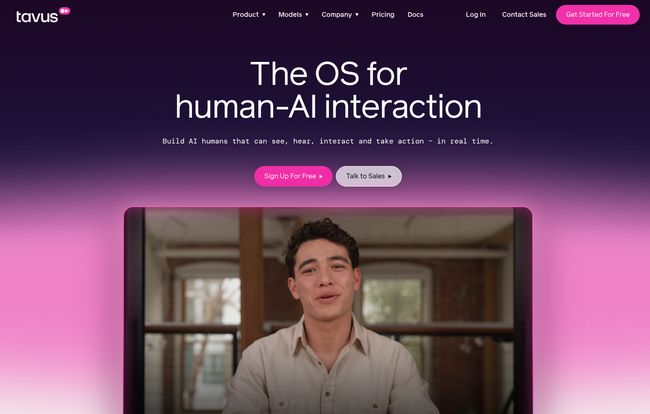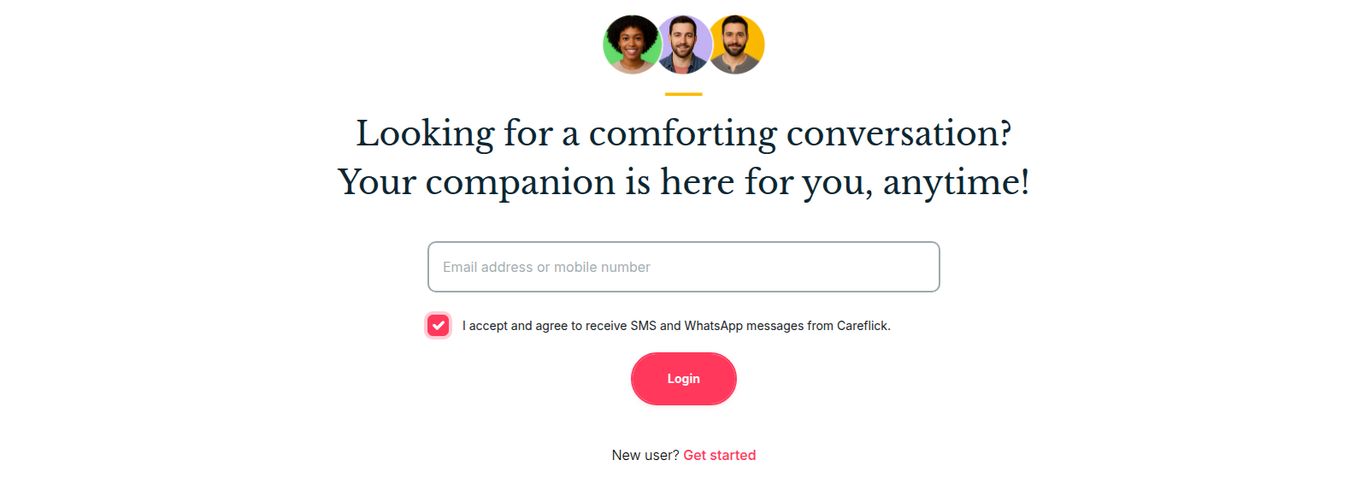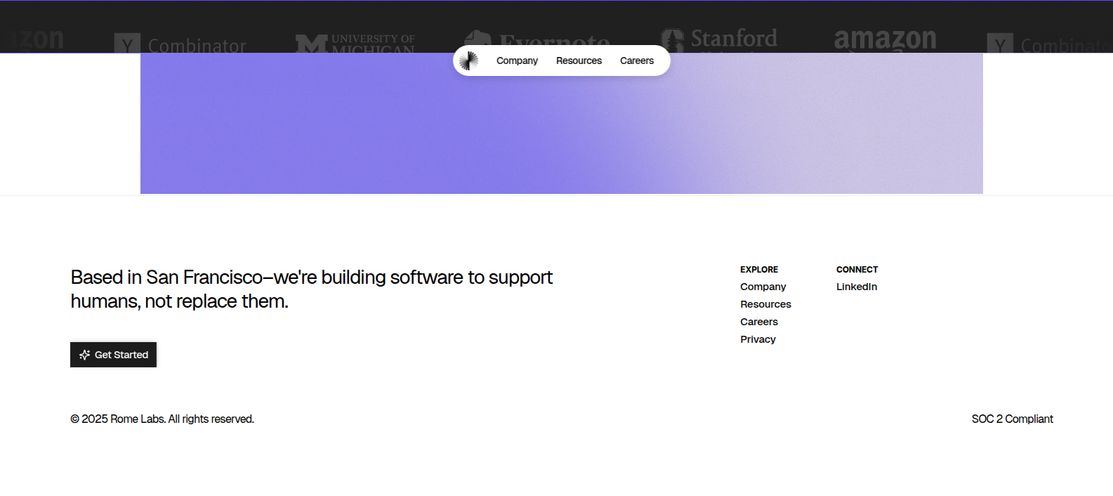For years, we’ve been promised the moon when it comes to AI interaction. We got... well, we got chatbots. You know the ones. The clunky, frustrating pop-ups that feel like you’re trying to navigate a phone tree from hell. They're a necessary evil for customer support queues, I guess, but they're hardly 'human'. Every time a company slaps an AI-powered avatar on their site, my eyes just glaze over. It's usually just a slightly more animated FAQ section.
So, when I first stumbled upon Tavus and their tagline—"The OS for human-AI interaction"—I was skeptical. Extremely skeptical. But then I started digging, and my cynicism started to... fade. This isn’t just another tool that generates personalized sales videos (though it can do that). This feels different. It's aiming to be the foundational layer, the very operating system, for building AI that you can actually look in the eye and talk to. And for a tech and traffic guy like me, that’s a pretty big deal.
So, What on Earth is Tavus, Really?
Forget what you think you know about AI video tools for a second. Tavus describes itself as an AI video research company. They're not just packaging up OpenAI's latest model with a pretty interface. They're building their own models—Phoenix-3, Sparrow-B, you get the picture—to tackle the messy, complicated business of making digital interactions feel genuine. The goal isn't just to create an avatar; it's to create a digital twin. A replica with a brain, not just a moving mouth.
Their whole platform is built around a suite of APIs that let developers create white-labeled experiences. This means you’re not getting a bot that screams “Powered by Tavus.” You’re getting the building blocks to create your brand’s AI persona, one that can see, hear, and respond in real-time with shockingly good realism. It's like they're handing you the keys to the workshop instead of just selling you the finished car.

Visit Tavus
The Tech That Makes It All Work
The magic isn't just one single thing. It’s a combination of a few core technologies that work together to create a believable experience. Some might argue that no AI can ever be truly 'human', and they're probably right. But Tavus is getting scarily close to passing the uncanny valley test.
The Conversational Video Interface (CVI)
This is the heart of it all. The CVI is what enables real-time, face-to-face conversation with an AI. Think of it less like a chatbot and more like a FaceTime call with a digital entity. It's designed for low-latency, responsive dialogue, which is absolutely critical. There's nothing that shatters the illusion of intelligence faster than an awkward, three-second pause while the AI “thinks.” We've all been there.
Seriously Impressive Video and Lip Sync
This is where my jaw kinda dropped. The biggest giveaway for most AI video has always been the lip sync. It's either slightly off, floaty, or just plain weird. Tavus has clearly poured a ton of R&D into this. Their models create fluid, natural facial movements and sync them to speech with a precision that I haven't seen in many other platforms. It's the difference between a puppet and a person. They also handle face-rendering, emotional intelligence cues, and speech models, making the entire package feel more cohesive. It’s not just a talking head; it’s an entity that can express itself.
A Modular, White-Labeled Dream
For any product team or developer, this is huge. Tavus is built like a set of high-tech LEGOs. You can swap out components as needed. Want to use a different Large Language Model (LLM)? Go for it. Have your own Retrieval-Augmented Generation (RAG) system? Plug it in. This modularity gives you an insane amount of control and future-proofs your work. You're not locked into their ecosystem forever. And the white-labeling means your brand stays front-and-center, which is exactly how it should be.
Let's Talk About the Price Tag
Okay, this is always the big question. How much does this futuristic tech cost? The pricing model is actually pretty accessible, but it’s something you need to understand before jumping in.
Tavus uses a tiered, subscription-plus-usage model. Here’s a quick breakdown:
- Free Plan ($0/mo): This is your sandbox. It's designed for developers who just want to kick the tires and see what's possible. You get API access, one replica, and some limited usage. It's a genuinely useful free tier for experimentation.
- Starter Plan ($59/mo + usage): For the serious builder who's starting to craft actual experiences. This bumps up your limits on replicas, conversational minutes, and video generation. The pay-as-you-go usage means you only pay for what you actually use beyond the base amount.
- Growth Plan ($397/mo + usage): This is for teams that are putting their AI into production. It comes with much higher limits, priority support, and is built for handling real-world traffic.
- Enterprise Plan (Custom): For the big players. We're talking custom contracts starting at $12k a year, with dedicated support, scaling discounts, and all the bells and whistles.
The “pay as you go” part is a double-edged sword. It’s fantastic because you’re not paying for a massive capacity you don’t need. But, you have to keep an eye on your usage, because if your AI experience goes viral, your costs will scale with it. It's a good problem to have, but one to plan for.
The Good, The Not-So-Bad, and The Beta
No tool is perfect, and a balanced look is always best. I've worked in SEO and digital marketing long enough to know that there's always a trade-off.
What I'm Genuinely Excited About
The quality of the models is top-tier. I mean, you can see it in their demos. The realism is a step above. The API-first approach is also a huge win in my book. It shows they understand their audience: builders and developers. They’re not trying to be a simple, one-click solution for everyone; they’re providing powerful tools for the people creating what's next. The flexibility and brand control you get with the white-labeled solution is the cherry on top. I’ve always felt that forcing your own branding onto a client's product is a bit of a cheap shot, and Tavus avoids that completely.
A Few Things to Keep in Mind
The scaling price is the main thing. It’s not a con, per se, but it requires financial planning. You need to model your costs. Also, training a custom replica of a specific person comes with its own costs, which is standard for this kind of tech but worth noting. Finally, some of their coolest features, like the full Lip Sync Suite, are still listed as being in beta. This isn’t a red flag—it just means the tech is evolving and you might encounter some rough edges. It's the price of being on teh cutting edge.
So, Is Tavus the Future?
Look, the term 'game-changer' is thrown around so much in tech that it’s lost all meaning. But Tavus… it feels significant. It's a pivot away from single-purpose AI tools and toward a foundational platform for a new kind of interaction. We’re moving from typing at bots to talking with digital beings.
This isn't for everyone. If you just need to send 1,000 personalized outreach videos with a name dropped in, other tools might be simpler. But if you are building an application, a service, or an experience that needs a human-like conversationalist at its core—for virtual concierges, AI-driven education, next-gen customer support, or things we haven't even imagined yet—then Tavus should be at the very top of your list to check out. It’s ambitious, powerful, and maybe, just maybe, it’s the OS for the next chapter of the internet.
Frequently Asked Questions about Tavus
- What is a 'digital twin' in the context of Tavus?
- A digital twin here isn't just a 3D model. It's a conversational AI replica of a person, designed to look, sound, and interact like them in real-time. It combines video, voice, and an AI 'brain' (LLM) to create a believable, interactive persona.
- Can I use my own voice and face for the AI?
- Yes, that's the core idea behind their "Replica" technology. Tavus allows for custom replica training where you can create a digital version of a specific person, but this is a premium feature with associated costs.
- Is Tavus easy for developers to get started with?
- Yes, it's built with a developer-first, API-centric approach. The documentation is clear, and the system is designed to be integrated into other applications. The free plan is specifically there to make it easy for developers to experiment without commitment.
- How does the pay-as-you-go pricing actually work?
- Your monthly subscription (Starter or Growth) includes a certain number of minutes for the CVI, video generation, etc. If you use more than that included amount, you are billed for the extra usage at a per-minute or per-credit rate. It provides flexibility but requires monitoring your consumption.
- What makes Tavus different from other AI video generators?
- The main difference is the focus on real-time, two-way conversation. Most AI video generators are for creating and distributing static, one-way videos. Tavus is an operating system for building interactive experiences where the AI responds to you face-to-face.
Conclusion
At the end of the day, Tavus is one of the most interesting platforms I've reviewed in a while. It’s not just iterating on existing tech; it feels like it's building a new category. The push for realism, the developer-friendly tools, and the sheer ambition of creating an OS for human-AI interaction is compelling. While it’s a sophisticated platform aimed at builders, the doors it opens are incredible. If you're in the business of building the future, you should probably have Tavus on your radar. It’s a glimpse of where we're headed, and it's an exciting view.



